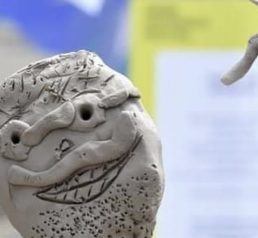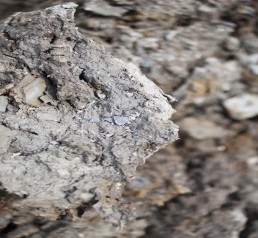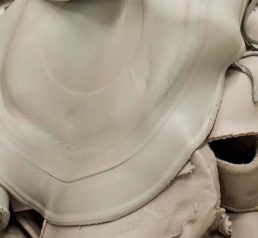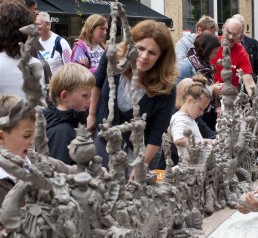Clues to life on Mars likely to be found in clays, Javier Cuadros
Clay Mineralogy Researcher and Clayground Advisor, Javier Cuadros, is currently researching clay on Mars. He has kindly written this piece for Clayground. It brings us up to date with his latest research to establish more about the relationship between clay and the preservation of possible clues to organic life on Mars.
“The investigation of “biomarkers” on Mars is one of the greatest drives for exploration of the planet. Biomarkers are any type of organic compound indicating past life, found in minerals or mineral structures resulting from erosion. Living organisms are made up of organic molecules. Many biological molecules can be recognized because only living organisms produce them or because they produce them with a specifically recognisable structure. Some minerals may also indicate they were produced by living organisms. Microorganisms dissolve minerals to use their mineral nutrients (potassium, iron, magnesium, etc.) and they sometimes generate dissolution structures that indicate a biological origin, although most times a second test is necessary to be sure.
On Mars, the search has to focus on organic molecules, because the tools we can send into space on landers and rovers only allow this approach. The foremost problem when looking for biomarkers is that living organisms and their organic molecules degrade quickly after death. Conditions on the surface are so harsh that organic matter has little chance of surviving. The most damaging element of all on Mars’ surface is ultra-violet light. Hence careful selection of rocks and geological environments is needed to maximize the chances of finding organic matter preserved at all, or to find it in the least degraded state possible. This is a difficult task on Mars. If life ever existed there, it was probably about 3,500 million years ago or more.
On Earth, we performed laboratory experiments to see how amino acids are preserved in minerals that exist on Mars’ surface, including three clays. The minerals were spiked with amino acids and inserted in a Mars chamber with a Mars-like atmosphere, ultra-violet radiation and temperature cycles ranging from minus 80 to 20°C, to replicate night-day cycles on Mars. The images below show a general view of the chamber (left) and the samples within the chamber (right); the samples are the little coloured discs in the box. This Mars chamber is located at the Open University in Milton Keynes.

After the experiments the organic matter was extracted from the minerals and the amount of remaining amino acids measured. The results indicate the relative ability of the minerals to protect the amino acids from the harsh conditions in the Mars chamber. We concluded, from the first approach, that Martian rocks or sediments rich in clays and sulphates (like gypsum) are good candidates as places to look for biomarkers.
What does this mean for Mars exploration? It means that clays and sulphates are a good target site for the rovers to search for organic biomarkers. These minerals protect amino acids from the harsh conditions on Mars better than other minerals. What is true for amino acids is probably also true for other organic compounds, although specific studies are in progress. Thus, it is likely that the chances of finding indicators of past life are greater in clays and sulphates than in other types or rock. This information is no surprise. We know that, on Earth, clay-rich sediments retain organic matter for enormous amounts of time and that they protect it from decay better than other minerals. The environments where we find these clay-rich sediments however, have important differences with the environments found on Mars and one cannot immediately jump to conclusions about where to look for biomarkers on Mars.
As the rover on Mars moves around, decisions need to be made as to which rocks in its path to study, because only a few can be investigated. The information provided in this study will be taken into account by the scientists and engineers as NASA’s Curiosity, now in full operation, and future rovers, like ESA’s ExoMars rover to be launched in 2020 (if all goes well), as they are steered on Mars. Furthermore, decisions about where to land these vehicles in the future could be heavily influenced by these findings. If a mission has as its main goal the search for traces of life, it may well be best to land in a place where clays and/or sulphates are abundant.
There is something friendly about clay: the softness, texture, its ability to be moulded. And this friendliness extends to life in the most general sense. Clay is a very positive influence for the development of microorganisms and plants, which boost other types of life too. Clay also retains the components of life after it disappears and maintains the record of it for long periods of time.”
Javier Cuadros is a Clay Mineralogy Researcher. We thank him for his continuous support in providing advice on the amazing properties of clay that science is bringing to light, on Earth and the entire Solar System.
-
Pandemic clay action!
18th Aug 21
-
The Volcano and the Microbes: interaction between geology and biology
4th Jun 21
-
Perseverance: a new NASA rover continues to follow Martian clay
2nd Aug 20
-
Research into clay provides clues as to how much water there was on Mars
18th Sep 19
-
22 Hands: British Ceramics Biennial Commission
12th Aug 19
-
Clayground Summer Events
24th Jun 19
-
Colourful Clays on Mars
20th Feb 19
Thames foreshore fragments and visual references
4th Dec 12
How is clay formed? Is it inorganic or organic?
10th Sep 12
CLAY FROM AROUND THE WORLD
3rd Aug 11
Clay Cargo 2014 Collection: the Thames Foreshore
15th Dec 14
Clues to life on Mars likely to be found in clays, Javier Cuadros
5th Aug 16
Clay Cargo 2013-2015
15th Jun 15
Sessions on the Clay Cargo boat, hosted by Fordham Gallery
9th Mar 15
Civic Spaces, Exhibitions
Museums and Galleries, Regeneration
Maker spaces, Rural Sites
Archaeology
Youth and Adult Community Groups, Professionals
Art Groups, Families, Students
Collaborations, Archaeology Sheets
Commissions, Thinking Hands? Research
Knowledge Exchange






